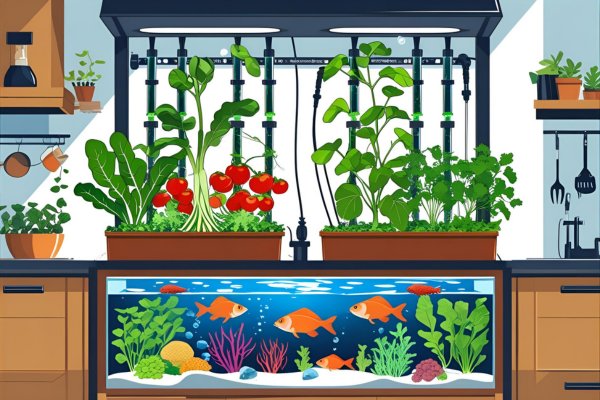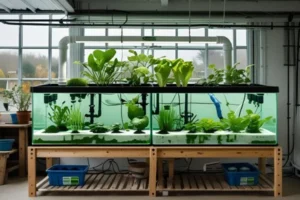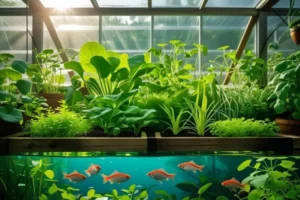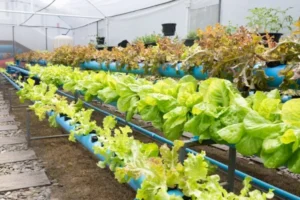DIY aquaponics has experienced explosive growth over the past 5 years, with home system installations increasing by 240% according to recent agricultural surveys. This sustainable farming method combines aquaculture (fish farming) with hydroponics (soilless plant cultivation), creating a symbiotic ecosystem that produces both fresh fish and vegetables using 90% less water than traditional gardening methods.
However, many aspiring growers face significant barriers when considering aquaponics. Commercial systems typically cost between 3,000 to 15,000 USD for a family-sized setup, while the perceived complexity of balancing fish health, plant nutrition, and water chemistry intimidates newcomers. Common concerns include maintaining proper pH levels (6.8-7.2), managing ammonia levels below 0.25 ppm, and ensuring adequate dissolved oxygen above 5 ppm for fish survival.
The reality is that DIY aquaponics systems can be built for as little as 200 to 800 USD using readily available materials from hardware stores and online suppliers. A basic 100-gallon fish tank system can feed a family of 4 people with fresh lettuce, herbs, and tomatoes year-round, while producing 20-30 pounds of fish annually. The learning curve typically spans 30-60 days for beginners to achieve system stability.
This comprehensive guide will walk you through every step of building your first DIY aquaponics system, from selecting the right components to troubleshooting common problems. You’ll discover proven techniques used by thousands of successful home growers, learn to avoid costly mistakes that plague 70% of first-time builders, and gain the confidence to start producing fresh, organic food within 4-6 weeks. Whether you have a basement, garage, greenhouse, or backyard space as small as 6 feet × 8 feet, this guide will help you create a thriving aquaponics ecosystem tailored to your space and budget.
What is DIY Aquaponics and Why Choose It?
DIY aquaponics represents a revolutionary approach to sustainable food production that anyone can implement at home. This closed-loop system mimics natural ecosystems where fish waste provides nutrients for plants, while plants filter and clean water for fish. The process relies on beneficial bacteria that convert fish waste (ammonia) into plant-available nutrients (nitrates) through a biological process called nitrification, typically establishing within 4 to 6 weeks.
The financial advantages of DIY aquaponics are compelling. While commercial aquaponics systems range from 3,000 to 15,000 USD, a well-designed DIY system costs 70% to 85% less. A basic 100-gallon setup produces approximately 15 to 20 pounds of leafy greens monthly and 25 to 35 pounds of fish annually, equivalent to 150 to 250 USD worth of organic produce and protein per month. Over 12 months, this represents potential savings of 1,800 to 3,000 USD compared to purchasing equivalent organic food.
Water efficiency makes DIY aquaponics exceptionally sustainable. Traditional soil gardening requires 15 to 25 gallons of water per pound of vegetables produced, while aquaponics uses only 2 to 3 gallons per pound – a 90% reduction. The recirculating system loses water only through evaporation (approximately 1% to 2% daily) and plant transpiration, making it ideal for drought-prone regions or areas with water restrictions.
Space efficiency is another key advantage. A 4 feet × 8 feet aquaponics system can produce the same vegetable yield as a 100 to 150 square foot traditional garden. Vertical growing towers can increase production density by 300% to 400%, making DIY aquaponics perfect for urban environments, apartments with balconies, or small backyards.
The learning curve, while initially steep, provides long-term food security and self-sufficiency. Most beginners achieve system stability within 45 to 90 days, after which maintenance requires only 15 to 30 minutes daily. This investment in knowledge pays dividends through reduced grocery bills, improved nutrition, and the satisfaction of producing pesticide-free food year-round, regardless of weather conditions or supply chain disruptions.
Essential Components for Your DIY Aquaponics System
Building a successful DIY aquaponics system requires specific components that work together to maintain the delicate balance between fish, plants, and beneficial bacteria. Understanding these essential elements and their costs helps you budget effectively and source materials efficiently.
Fish Tank: The heart of your system requires a food-grade container holding 50 to 100 gallons for beginners. IBC totes (275 gallons) cost 75 to 150 USD and provide excellent value, while food-grade plastic tanks (100 gallons) range from 200 to 350 USD. Avoid containers that previously held chemicals, as residues can harm fish. The tank should be opaque or covered to prevent algae growth and maintain stable water temperatures between 70°F to 78°F.
Grow Beds: These containers hold your growing medium and plants. Standard dimensions are 2 feet × 4 feet × 12 inches deep, requiring 4 to 6 cubic feet of growing medium. Food-grade plastic storage containers cost 25 to 50 USD each, while custom-built wooden beds with pond liner cost 75 to 125 USD per bed.
Growing Medium: Expanded clay pebbles (hydroton) cost 35to45 USD per 50-liter bag and provide excellent drainage and surface area for beneficial bacteria. Alternatives include pea gravel (15 to 25 USD per 50 pounds) or lava rock (20 to 30 USD per 50 pounds).
Water Pump: A submersible pump rated for 400 to 800 gallons per hour (GPH) costs 45 to 85 USD. The pump should cycle the entire system volume once every 1 to 2 hours. Energy-efficient models consume 35 to 65 watts, adding 15 to 30 USD monthly to electricity bills.
Air Pump and Stones: Fish require dissolved oxygen levels above 5 ppm. A dual-outlet air pump (10 to 20 watts) costs 25 to 45 USD, with air stones at 8 to 15 USD each. The system needs 1 air stone per 25 gallons of water volume.
Plumbing Supplies: PVC pipes, fittings, and tubing total 50 to 100 USD. Use 3/4-inch to 1-inch pipes for main water lines and 1/2-inch tubing for smaller connections.
Step-by-Step Guide: Building Your First DIY Aquaponics System
Choosing Your System Type
For beginners, a media bed system offers the simplest design and most forgiving operation. This flood-and-drain setup requires one grow bed positioned 12 to 18 inches above the fish tank. The 1:1 ratio (100-gallon fish tank with 100-gallon grow bed capacity) provides optimal nutrient processing. Expect 2 to 3 days for initial assembly and 300 to 500 USD total investment for a complete starter system.
Setting Up the Fish Tank
Position your fish tank on a level surface capable of supporting 900 to 1,000 pounds (water weight plus tank). Install the submersible water pump in the deepest corner, approximately 2 to 3 inches from the bottom. Connect 3/4-inch PVC pipe from pump to grow bed, ensuring 4 to 6 feet of head pressure capability. Add the air pump with air stones positioned opposite the water pump to create optimal circulation patterns.
Installing the Grow Bed
Mount the grow bed 12 to 18 inches above the fish tank using sturdy supports rated for 400 to 500 pounds. Install a bell siphon or timer-controlled drain system to flood beds every 15 to 30 minutes. The grow bed should drain completely within 5 to 10 minutes to prevent root rot and maintain oxygen levels. Fill with 4 to 6 inches of growing medium, leaving 2 to 3 inches of freeboard.
Creating the Water Circulation System
Connect the water pump to deliver 400 to 600 gallons per hour to the grow bed. Install a ball valve to control flow rate, maintaining gentle flooding that won’t disturb fish or growing medium. The return pipe from grow bed to fish tank should be 1 to 1.5 inches diameter to handle peak drainage flow without overflow.
Adding Biological Filtration
Beneficial bacteria colonize the growing medium within 3 to 6 weeks. Add bacterial starter culture (15 to 25 USD) to accelerate cycling. Monitor ammonia levels daily, expecting 0.5 to 2.0 ppm initially, dropping to below 0.25 ppm once established. Maintain water temperature between 70°F to 78°F for optimal bacterial growth and fish health.
Best Fish and Plant Combinations for Beginners
Recommended Fish Species
Tilapia remains the gold standard for DIY aquaponics, tolerating water temperatures from 65°F to 85°F and pH levels between 6.5 to 8.5. Stock 1 fish per 5 to 10 gallons, reaching 1 to 2 pounds within 6 to 9 months. Fingerlings cost 2to4 USD each, with feed conversion ratios of 1.5:1 (1.5 pounds of feed produces 1 pound of fish). Tilapia consume 2% to 3% of their body weight daily in high-quality pellets.
Goldfish offer excellent beginner alternatives, surviving temperatures from 50°F to 80°F and requiring minimal care. Stock 1 goldfish per 10 to 20 gallons, with 4 to 6 inch fish producing adequate waste for nutrient cycling. While not typically harvested for food, they provide reliable waste production and cost only 3 to 8 USD per fish.
Channel Catfish thrive in cooler climates (60°F to 75°F) and tolerate poor water quality better than tilapia. Stock 1 catfish per 8 to 12 gallons, reaching 2 to 3 pounds within 12 to 18 months. Fingerlings cost 1.50 to 3 USD each.
Compatible Plant Varieties
Leafy Greens establish fastest and require lowest nutrient levels. Lettuce, spinach, and kale mature within 30 to 45 days, producing 4 to 6 ounces per plant. Start with 20 to 30 plants per 100 gallons of fish tank volume.
Herbs like basil, cilantro, and parsley grow rapidly and command premium prices (8 to 12 USD per pound). These plants mature within 21 to 35 days and tolerate fluctuating nutrient levels during system cycling.
Fruiting Plants like tomatoes and peppers require established systems (3+ months old) with stable nitrate levels above 40 ppm. These plants need 60 to 90 days to maturity and produce 2 to 5 pounds per plant annually.
Introduction Timeline
Introduce fish first, allowing 4 to 6 weeks for bacterial establishment before adding plants. Start with hardy leafy greens, then progress to herbs after 2 to 3 months, and finally fruiting plants after 4 to 6 months of stable operation.
Common DIY Aquaponics Challenges and Solutions
Fish Health Issues
Problem: Fish mortality during the first 30 to 60 days often results from poor water quality or overfeeding. New aquaponic enthusiasts frequently lose 20% to 40% of their initial fish stock, costing 50 to 200 USD in replacement fish.
Solution: Maintain strict feeding schedules of 1% to 2% of fish body weight daily, split into 2 to 3 feedings. Monitor ammonia levels daily during cycling, keeping below 0.5 ppm. Quarantine new fish for 7 to 14 days before introducing them to the main system. Stock conservatively at 1 fish per 8 to 10 gallons initially.
Plant Nutrient Deficiencies
Problem: Iron deficiency manifests as yellowing leaves within 3 to 5 weeks of planting, affecting 80% to 90% of new systems. Potassium and calcium deficiencies follow, stunting growth and reducing yields by 40% to 60%.
Solution: Add chelated iron supplements monthly at 1 to 2 ppm concentration (12 to 18 USD per bottle). Supplement potassium with potassium hydroxide (1 teaspoon per 100 gallons weekly) and calcium through crushed eggshells or calcium carbonate. Monitor EC levels between 1.2 to 2.0 for optimal nutrient availability.
System Imbalances
Problem: Algae blooms occur when systems receive more than 6 to 8 hours of direct sunlight daily, consuming oxygen and competing with plants. Green water typically appears within 10 to 14 days of excessive light exposure.
Solution: Shade fish tanks completely and limit grow bed light exposure to 12 to 14 hours daily using LED grow lights (30 to 50 watts per square foot). Install UV sterilizers (85 t o150 USD) for severe cases, running 4 to 6 hours daily until water clears.
Pump Failures
Problem: Pump failures cause system crashes within 2 to 4 hours, leading to fish death and plant stress. Replacement pumps cost 45 to 85 USD plus overnight shipping fees.
Solution: Install backup air pumps (25 to 40 USD) and maintain spare pump components. Check pumps weekly for debris and calcium buildup, cleaning monthly with vinegar solutions.
Maintenance and Optimization Tips
Daily and Weekly Maintenance Routines
Daily Tasks (5 to 10 minutes): Check fish behavior and appetite during feeding times. Healthy fish should consume food within 3 to 5 minutes. Monitor water levels, adding 2% to 5% daily due to evaporation. Remove dead plant matter and uneaten food within 30 minutes of feeding to prevent ammonia spikes.
Weekly Tasks (30 to 45 minutes): Test water parameters using digital meters or test strips (15 to 30 USD monthly supply cost). Clean pump intake screens and air stones to maintain optimal flow rates of 400 to 600 gallons per hour. Harvest mature plants and replant seedlings to maintain continuous production cycles. Trim plant roots extending beyond 6 to 8 inches to prevent clogging.
System Optimization Strategies
Maximize Growing Space: Install vertical growing towers to increase plant capacity by 200% to 300% within the same footprint. PVC tower systems cost 25 to 40 USD per 4-foot section and support 15 to 20 additional plants. Position towers to receive 12 to 14 hours of light daily.
Improve Water Flow: Add venturi valves (8 to 15 USD each) to increase dissolved oxygen levels by 15% to 25%. Install multiple smaller pumps rather than one large pump to create redundancy and improve circulation patterns. Timer-controlled feeding systems (45 to 75 USD) prevent overfeeding and maintain consistent schedules.
Seasonal Adjustments
Winter Optimization: Install aquarium heaters (150 to 300 watts) costing 35 to 65 USD to maintain 70°F to 75°F water temperatures. Reduce feeding frequency to every other day when temperatures drop below 65°F. Add insulation around fish tanks using foam boards (20 to 30 USD for materials).
Summer Management: Increase aeration capacity by 50% during hot weather above 80°F. Install shade cloth (40% to 60% density) costing 15 to 25 USD to prevent overheating. Monitor evaporation rates, which can double from 2% to 4% daily during peak summer months.
Productivity Tracking: Maintain harvest logs recording yields per square foot. Optimized systems produce 8 to 12 pounds of vegetables monthly per 100-gallon fish tank, worth 40 to 80 USD in grocery store equivalent value.
Cost Analysis: DIY vs Commercial Systems
Initial Investment Comparison
DIY Systems: A complete 100-gallon DIY aquaponics system costs 300 to 500 USD for materials and requires 15 to 25 hours of assembly time. Components include IBC tote (75 to 150 USD), grow bed materials (50 to 100 USD), pumps and plumbing (75 to 125 USD), and growing medium (35 to 50 USD). Additional tools and miscellaneous supplies add 65 to 75 USD to total costs.
Commercial Systems: Equivalent commercial units range from 1,200 to 2,500 USD for similar capacity, representing a 300% to 400% premium over DIY builds. However, commercial systems include warranties (1 to 3 years), technical support, and professional installation services worth 200 to 400 USD in value.
Operational Costs and ROI Analysis
Monthly Operating Expenses: Both system types share similar operational costs. Electricity for pumps and lighting averages 25 to 45 USD monthly. Fish food costs 15 to 25 USD monthly for 20 to 30 fish. Seeds and growing supplies add 10 to 20 USD monthly.
Production Capacity: DIY and commercial systems of equal size produce comparable yields of 8 to 12 pounds of vegetables monthly, worth 40 to 80 USD in grocery store equivalent value. Fish harvests every 6 to 9 months yield 15 to 25 pounds worth 75 to 150 USD.
Return on Investment: DIY systems achieve break-even within 6 to 10 months, while commercial systems require 18 to 30 months due to higher initial costs. Over 5 years, DIY systems save 2,000 to 3,500 USD compared to purchasing equivalent commercial units.
Long-term Value Considerations
Maintenance and Upgrades: DIY systems offer unlimited customization potential and lower replacement part costs (50% to 70% savings). Commercial systems provide standardized components and professional troubleshooting support but limit modification options.
Scalability: DIY knowledge enables cost-effective expansion at 200 to 300 USD per additional 100-gallon capacity. Commercial system expansions cost 800 to 1,500 USD for equivalent capacity increases.
Learning Value: DIY construction provides invaluable hands-on experience worth 500 to 1,000 USD in practical knowledge, enabling better system management and troubleshooting capabilities throughout the system’s 10 to 15 year operational lifespan.
Conclusion
DIY aquaponics represents an accessible pathway to sustainable food production, combining the satisfaction of hands-on construction with meaningful environmental impact. Your initial investment of 300 to 500 USD and 15 to 25 hours of assembly time can generate 500 to 1,200 USD worth of fresh produce and protein annually, achieving complete return on investment within 6 to 10 months.
The journey from system assembly to first harvest spans just 6 to 8 weeks, with continuous production cycles delivering 8 to 12 pounds of vegetables monthly thereafter. Beyond the immediate financial benefits, you’ll develop invaluable skills in water chemistry, plant nutrition, and sustainable agriculture while reducing your household’s environmental footprint by up to 90% compared to traditional farming methods.
Success depends on understanding the fundamental principles: maintaining the nitrogen cycle, balancing fish and plant ratios, and establishing consistent maintenance routines. The learning curve may seem steep initially, but thousands of DIY enthusiasts worldwide prove that anyone can master these systems with patience and dedication.
Your aquaponics system will evolve from a simple food production method into a cornerstone of self-sufficiency, potentially inspiring community involvement and educational opportunities. As you gain experience, expansion becomes increasingly cost-effective, with additional 100-gallon capacity modules adding just 200 to 300 USD to your growing operation.
The time to start is now – every day you delay represents missed harvests and continued dependence on conventional food systems.
Have you started planning your DIY aquaponics system? Share your questions, challenges, or success stories in the comments below! Whether you’re just beginning to research or already building your first system, our community is here to help you succeed. What’s your biggest concern about starting with aquaponics?
Frequently Asked Questions (FAQ)
How long does it take to see the first harvest?
Leafy greens like lettuce and spinach provide your first harvest within 30 to 45 days after planting, while herbs mature in 21 to 35 days. Fish require 6 to 9 months to reach harvestable size (1 to 2 pounds). Your system becomes fully productive after 3 to 4 months of operation.
What’s the minimum space required for a DIY aquaponics system?
A functional starter system fits within 6 to 8 square feet of floor space and requires 7 to 8 feet of vertical clearance for lighting. Balcony and patio systems work well in spaces as small as 4 x 4 feet, producing enough vegetables for 1 to 2 people.
How much does it cost to operate monthly?
Expect 50 to 90 USD monthly operating costs including electricity (25 to 45 USD), fish food (15 to 25 USD), and growing supplies (10 to 20 USD). Energy-efficient LED lights and pumps reduce electricity costs by 40% to 60% compared to traditional equipment.
Can I use regular fish food, or do I need special aquaponics feed?
High-quality commercial fish pellets work perfectly for aquaponics. Choose feeds with 32% to 40% protein content and avoid cheap brands containing excessive fillers. Budget 20 to 35 USD monthly for quality feed to maintain optimal fish health and plant nutrition.
What happens if my pump fails?
Pump failures create emergencies within 2 to 4 hours. Install battery-powered backup air pumps (25 to 40 USD) to maintain oxygen levels during outages. Keep spare pump parts and a backup water pump (45 to 75 USD) for immediate replacement.
Do I need permits or licenses for home aquaponics?
Most residential aquaponics systems require no permits when used for personal consumption. Check local zoning laws regarding water features and electrical installations. Commercial sales may require food handling permits varying by state and municipality.
How do I prevent mosquitoes and pests?
Maintain continuous water circulation and stock mosquito-eating fish like goldfish or guppies. Cover water surfaces with fine mesh screens and eliminate standing water areas. Beneficial insects and companion planting provide natural pest control without chemicals.



